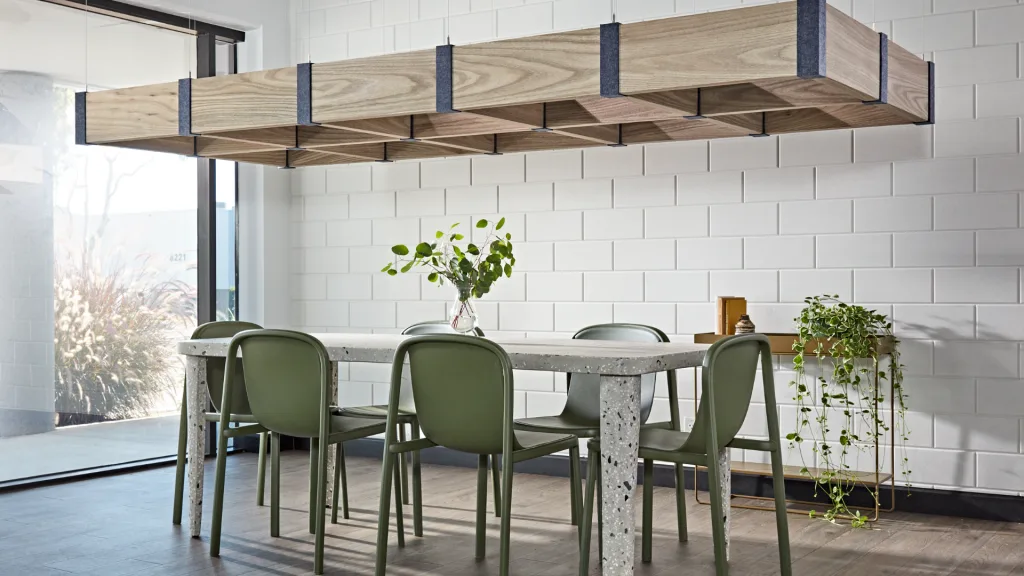We’ve all been in noisy places. Imagine trying to chat in a café where every clatter echoes, drowning your words. Or working in an open-plan office, where overlapping conversations and video calls make concentration a distant dream. Simply put, noise is disruptive. But the good news is, there are smart design strategies to tackle this.
Poor acoustics affect more than just our ears; they mess with our minds too. Research highlights that exposure to noisy environments can spike stress levels and hamper performance. From offices to schools, bad acoustics can lead to reduced focus and even emotional distress. But what if there’s a way to flip this narrative through smarter design? Let’s explore.
Acoustics Gear to Up Workplace Productivity
In both schools and workplaces, sound management is critical. Poor acoustics can seriously disrupt learning and focus, messing with both student performance and worker efficiency. To tackle this, modern office designs are incorporating diverse spaces tailored for individual tasks and group collaboration. This includes sound-insulating materials like acoustic tiles and baffles, which help create an environment friendly to concentration. The result? Places where people actually want to work and learn.
Key Principles of Noise-Reducing Design
Often, businesses skimp on acoustics for the sake of style or cost. But blending three core design principles can create comfortable spaces. First, using high NRC materials—like carpets and draperies—reduces noise effectively. Second, sticking to more line designs than right angles minimizes echoes. Lastly, optimizing the ceiling as the ‘fifth wall’ can make a massive difference. These tweaks make any room more pleasing, lowering noise without losing style.
Effective materials can transform sound landscapes. Think of acoustic panels placed three to seven feet high; they absorb sound where it mostly occurs. Sustainable options like those from recycled materials add an eco-benefit too. By breaking up flat surfaces with creative angles or choosing sound-friendly furniture, we can make rooms quieter. This shows that tackling noise is not just about adding panels; it’s about integrating thoughtful design elements.
Sound Management from Top to Bottom
Ceilings can make or break acoustics. With exposed ducts and concrete, sound bounces around, amplifying noise levels. But introducing absorptive elements like baffles can calm things down. In one vivid example, a domed cafeteria was turned into a much quieter place, with just the right acoustic tweaks.
When considering ceiling design, it’s important to look at the whole room. This holistic view ensures that every element works together to absorb rather than amplify noise. Consulting with acoustics experts can really help in designing a sound-friendly space. This way, noisy intrusions like echoes become a thing of the past, making spaces more livable.
The synergy between different noise-reducing strategies is what truly makes a difference. It’s like having a well-orchestrated choir; each sound piece needs to harmonize with the others to reduce overall noise. This helps create spaces where people feel relaxed and focused, free from the chaos of uncontrolled sound.
Creating Spaces You’ll Love
Acoustics should sit up there with lighting and layout in terms of design importance. Properly managed soundscapes not only enhance productivity but also make spaces feel more inviting. Whether it’s an office or a school, smart sound design supports mental well-being and focused learning. So, by thinking of sound as a part of design, we create environments people enjoy being in.
Acoustic design can be a secret weapon for spaces that want more foot traffic. Happy sound environments draw customers and make them want to stick around longer. This applies to retail, education, and even public spaces, where the right balance of sound can drastically enhance user experience. Sound can truly shape how people engage with an environment.
A Sustainable Solution
Eco-friendly acoustic solutions offer dual benefits: they reduce sound and are good for the planet. Products made from recycled PET or reclaimed materials are sustainable options that don’t compromise on sound quality. This makes them an appealing choice for eco-conscious businesses looking to improve their acoustic environments while being kind to the Earth.
Using these sustainable materials isn’t just a trend; it’s becoming a norm. The added benefit? They offer top-notch noise reduction, which can completely change how a room feels. For any environment, being green and silent is a winning combination.
Incorporating Acoustics into Everyday Design
With a little creativity, acoustics can be woven into the fabric of everyday design. It starts with understanding the space and its sound dynamics. From there, designers can think about integrating acoustic elements that fit seamlessly with the existing aesthetic. This way, sound control is both effective and stylish.
In a practical sense, this integration is about balance. Every room has its unique challenges, but addressing them upfront makes a significant difference. Effective design doesn’t have to sacrifice aesthetics for function; rather, the two should work hand-in-hand, ensuring spaces are both beautiful and peaceful.
Ultimately, when acousticians analyze an area, they look at factors like room shape, material, and how it’s used. This helps them advise on the right sound strategies. By working closely with design teams, they ensure solutions aren’t just thrown together but are part of a coherent plan.
Enhancing Spaces with Acoustic Experts
Professionals who specialize in acoustics bring valuable insights to the table. They look beyond just putting up a few panels and consider how the entire space can be optimized for sound. Their expertise ensures that each element is in place to reduce noise efficiently, enhancing the overall atmosphere.
Their role is critical, particularly in large, complex areas such as auditoriums or open office spaces. Acoustics experts understand the nuances of sound and how it interacts with architecture. Their input can turn a loud and chaotic environment into a peaceful sanctuary.
Real-World Applications of Acoustic Design
Schools, offices, and public spaces have all benefitted from strategic acoustic enhancements. Take, for example, an office reworked with varying materials and panel placements to combat noise. Studies show these settings improve focus and reduce stress, leading to happier occupants. Sound design truly transforms spaces.
The beauty lies in its adaptability. Every location can have its unique acoustic plan tailored to its needs. From quiet libraries to bustling cafés, the right design makes a world of difference. And most importantly, it contributes positively to users’ well-being.
Even retail spaces are seeing a boost. With thoughtful sound design, shopping becomes a more pleasant experience. Effective sound management is not a one-size-fits-all situation but requires customized solutions.
Taking Action for a Quieter Future
Let’s face it: Noise won’t cease to exist. However, by proactively improving the acoustics within spaces we control, we can mitigate its impact. It’s all about being strategic and intentional with design choices.
Adopting sound-friendly designs is more than a trend; it’s an investment in better living and working environments. As more recognize this, the world becomes a quieter, more harmonious place.
In a noisy world, the right design choices make all the difference. Sure, other distractions will remain, but with smart design, controlled sound enhances our day-to-day experiences, helping us thrive in more peaceful spaces.





